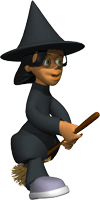Trick or Treat Safety Tips
For many people, autumn events like Halloween and Harvest Day are fun times to dress up in costumes, go trick-or-treating, attend parties, and eat yummy treats. These events are also opportunities to provide nutritious snacks, get physical activity, and focus on safety. But going out into the ghoulish night to troll for candy is not always as innocent as it seems. Parents and children alike want to enjoy their bit of frightful fun without real dangers lurking around every corner. Below are tips to help make the festivities fun and safe for trick-or-treaters and party guests.
 |
Swords, knives, and similar costume accessories should be short, soft, and flexible. |
 |
Avoid trick-or-treating alone. Walk in groups or with a trusted adult. |
 |
Fasten reflective tape to costumes and bags to help drivers see you. |
 |
Examine all treats for choking hazards and tampering before eating them. Limit the amount of treats you eat. |
 |
Hold a flashlight while trick-or-treating to help you see and others see you. |
 |
Always test make-up in a small area first. Remove it before bedtime to prevent skin and eye irritation. |
 |
Look both ways before crossing the street. Use established crosswalks wherever possible. |
 |
Lower your risk for serious eye injury by not wearing decorative contact lenses. |
 |
Only walk on sidewalks or on the far edge of the road facing traffic to stay safe. |
 |
Wear well-fitting masks, costumes, and shoes to avoid blocked vision, trips, and falls. |
 |
Eat only factory-wrapped treats. Avoid eating homemade treats unless you know the cook well. |
 |
Enter homes only if you're with a trusted adult. Otherwise, stay outside. |
 |
Never walk near lit candles or luminaries. Be sure to wear flame-resistant costumes. |
Here are some other Trick or Treat safety tips to think about and consider.
- Purchase flame resitant costumes. When purchasing a costume, masks, beards, and wigs, look for the label Flame Resistant. Although this label does not mean these items won't catch fire, it does indicate the items will resist burning and should extinguish quickly once removed from the ignition source. To minimize the risk of contact with candles or other sources of ignition, avoid costumes made with flimsy materials and outfits with big, baggy sleeves or billowing skirts.
- Choose costumes that fit properly and are light & bright enough to be seen.
- For greater visibility during dusk and darkness, decorate or trim costumes with reflective tape that will glow in the beam of a car's headlights. Bags or sacks should also be light colored or decorated with reflective tape. Reflective tape is usually available in hardware, bicycle, and sporting goods stores.
- To easily see and be seen, children should also carry flashlights.
- Costumes should be short enough to prevent children from tripping and falling.
- Children should wear well-fitting, sturdy shoes . Mother's high heels are not a good idea for safe walking.
- Hats and scarfs should be tied securely to prevent them from slipping over children's eyes.
- Wherever possible, use homemade costumes or non-toxic paint to replace store bought masks. Apply a natural mask of cosmetics rather than have a child wear a loose-fitting mask that might restrict breathing or obscure vision. Most masks are too hot and don’t provide an adequate visual field. Kids who can’t see where they are going can trip and fall. If a mask is used, however, make sure it fits securely and has eyeholes large enough to allow full vision.
- Swords, knives, and similar costume accessories should be of soft and flexible material.
- Begin trick or treating during the daylight. It used to be that everyone waited until dark for greater effect. Unfortunately, there are those who want to cause trouble and can only do so after dark. Now, trick or treating begins at dusk even if the sun is not down.

- Use a cloth tote bag or pillowcase to hold the candy. Plastic bags can buckle under the weight of the haul and your child could lose their loot on the front step or in the street. Plastic pumpkins don’t hold as much candy and the strap can break with the same results as a plastic bag.
- Stick together. Young children should always be accompanied by an adult or an older, responsible child. Never let a child go trick or treating alone. If you can’t do it, entrust your child’s care to another adult friend. Let them walk a few feet ahead to feel independent but not so far that they are out of your sight. All children should WALK, not run from house to house and use the sidewalk if available, rather than walk in the street. Children should be cautioned against running out from between parked cars, or across lawns and yards where ornaments, furniture, or clotheslines present dangers.
- For small children, drive instead of walk. The concept is the same as far as kids are concerned. Their friends will still see their costume and they still receive candy. As the night wears on it may get cold and little feet get tired quite quickly. A car means a faster exit when everyone is too tired to go on.

- Choose only safe houses. Children should go only to homes where the residents are known and have outside lights on as a sign of welcome. Children should not enter homes or apartments unless they are accompanied by an adult. People expecting trick-or-treaters should remove anything that could be an obstacle from lawns, steps and porches. Candlelit jack-o'-lanterns should be kept away from landings and doorsteps where costumes could brush against the flame. Indoor jack-o'-lanterns should be kept away from curtains, decorations, and other furnishings that could be ignited.
- Check the candy before letting any be eaten. It is a safety precaution that protects the kids. Not everyone is out to harm children but there have been incidents in the past where blades and pins were found in candy. Warn children not to eat any treats before an adult has carefully examined them for evidence of tampering.
- Refrain from taking homemade candy and treats. Even schools don’t accept homemade food items anymore. It is too easy to get sick and the liability is high. Homemade candy apples look scrumptious, but there is no list of ingredients to tell you what was used to create them. Stick to prepackaged candy for children to eat.
What You Can Do Around Your Own House!
- Provide healthier treats for trick-or-treaters, such as individual packs of raisins, trail mix, or pretzels. For party guests, offer a variety of fruits, vegetables, and cheeses.
- Use Halloween party games and trick-or-treat time as an opportunity for kids to get their daily dose of 60 minutes of physical activity.
- Be sure walking areas and stairs are well-lit and free of obstacles that could result in falls.
- Keep candle-lit jack-o’-lanterns and luminaries away from doorsteps, walkways, landings, and curtains. Place them on sturdy tables, keep them out of the reach of pets and small children, and never leave them unattended.
- Remind drivers to watch out for trick-or-treaters and to drive safely.
Trick or treat is a fun Halloween night tradition designed to scare us silly. In the process, don’t forget to take precautions so everyone is safe. Following these tips will help to make the festivities fun and safe for everyone!
| Pattern Categories Browse the categories to help you find the patterns you're looking for. |
||






